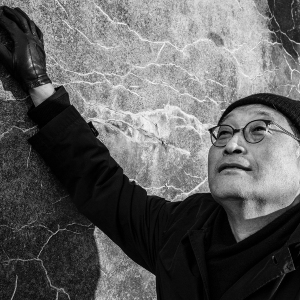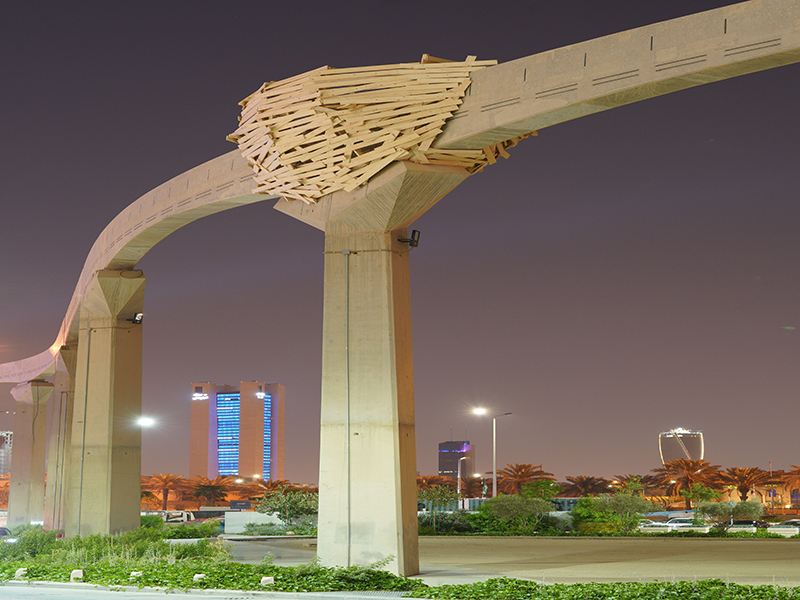
Since his days as a student of painting, in the 1970s, Tadashi Kawamata has been on an artistic journey that is remarkable for its lack of complacency. Taking nothing for granted, he engages us in a process that involves close consideration of the kinds of environments we make for ourselves, thereby raising questions of all-too-human need and desire.
He is renowned for his in-situ interventions, assembled from, among other things, wooden planks, chairs and barrels. Whether built up into fragile Babylonian constructions, tree huts, roof installations or stretched out to form serpentine, his works offer all those who encounter them, climb up onto them or set foot on them, another point of view – in every sense – over the place in which they are situated.
Born in 1953 in Hokkaidō, Japan, Tadashi Kawamata lives and works in Tokyo and Paris. His work has been widely shown in major international institutions such as MAAT, Lisbon, Pushkin Museum, Moscow, Centre Pompidou in Paris the Serpentine Gallery in London and many more.
WP_Query Object
(
[query] => Array
(
[post_type] => cpt_artworks
[post_status] => publish
[meta_query] => Array
(
[0] => Array
(
[key] => artworks_artist
[value] => 2472
[compare] => LIKE
)
)
)
[query_vars] => Array
(
[post_type] => cpt_artworks
[post_status] => publish
[meta_query] => Array
(
[0] => Array
(
[key] => artworks_artist
[value] => 2472
[compare] => LIKE
)
)
[error] =>
[m] =>
[p] => 0
[post_parent] =>
[subpost] =>
[subpost_id] =>
[attachment] =>
[attachment_id] => 0
[name] =>
[pagename] =>
[page_id] => 0
[second] =>
[minute] =>
[hour] =>
[day] => 0
[monthnum] => 0
[year] => 0
[w] => 0
[category_name] =>
[tag] =>
[cat] =>
[tag_id] =>
[author] =>
[author_name] =>
[feed] =>
[tb] =>
[paged] => 0
[meta_key] =>
[meta_value] =>
[preview] =>
[s] =>
[sentence] =>
[title] =>
[fields] =>
[menu_order] =>
[embed] =>
[category__in] => Array
(
)
[category__not_in] => Array
(
)
[category__and] => Array
(
)
[post__in] => Array
(
)
[post__not_in] => Array
(
)
[post_name__in] => Array
(
)
[tag__in] => Array
(
)
[tag__not_in] => Array
(
)
[tag__and] => Array
(
)
[tag_slug__in] => Array
(
)
[tag_slug__and] => Array
(
)
[post_parent__in] => Array
(
)
[post_parent__not_in] => Array
(
)
[author__in] => Array
(
)
[author__not_in] => Array
(
)
[search_columns] => Array
(
)
[ignore_sticky_posts] =>
[suppress_filters] =>
[cache_results] => 1
[update_post_term_cache] => 1
[update_menu_item_cache] =>
[lazy_load_term_meta] => 1
[update_post_meta_cache] => 1
[posts_per_page] => 11
[nopaging] =>
[comments_per_page] => 50
[no_found_rows] =>
[order] => DESC
)
[tax_query] => WP_Tax_Query Object
(
[queries] => Array
(
)
[relation] => AND
[table_aliases:protected] => Array
(
)
[queried_terms] => Array
(
)
[primary_table] => wp_posts
[primary_id_column] => ID
)
[meta_query] => WP_Meta_Query Object
(
[queries] => Array
(
[0] => Array
(
[key] => artworks_artist
[value] => 2472
[compare] => LIKE
)
[relation] => OR
)
[relation] => AND
[meta_table] => wp_postmeta
[meta_id_column] => post_id
[primary_table] => wp_posts
[primary_id_column] => ID
[table_aliases:protected] => Array
(
[0] => wp_postmeta
)
[clauses:protected] => Array
(
[wp_postmeta] => Array
(
[key] => artworks_artist
[value] => 2472
[compare] => LIKE
[compare_key] => =
[alias] => wp_postmeta
[cast] => CHAR
)
)
[has_or_relation:protected] =>
)
[date_query] =>
[request] => SELECT SQL_CALC_FOUND_ROWS wp_posts.ID
FROM wp_posts INNER JOIN wp_postmeta ON ( wp_posts.ID = wp_postmeta.post_id ) JOIN wp_icl_translations wpml_translations
ON wp_posts.ID = wpml_translations.element_id
AND wpml_translations.element_type = CONCAT('post_', wp_posts.post_type)
WHERE 1=1 AND (
( wp_postmeta.meta_key = 'artworks_artist' AND wp_postmeta.meta_value LIKE '{9680e68ade8ac7d4654abf1189d159fba6537e40677d811a664bbad59ac289f0}2472{9680e68ade8ac7d4654abf1189d159fba6537e40677d811a664bbad59ac289f0}' )
) AND wp_posts.post_type = 'cpt_artworks' AND ((wp_posts.post_status = 'publish')) AND ( ( ( wpml_translations.language_code = 'en' OR (
wpml_translations.language_code = 'en'
AND wp_posts.post_type IN ( 'qrcode' )
AND ( (
( SELECT COUNT(element_id)
FROM wp_icl_translations
WHERE trid = wpml_translations.trid
AND language_code = 'en'
) = 0
) OR (
( SELECT COUNT(element_id)
FROM wp_icl_translations t2
JOIN wp_posts p ON p.id = t2.element_id
WHERE t2.trid = wpml_translations.trid
AND t2.language_code = 'en'
AND (
p.post_status = 'publish' OR p.post_status = 'private' OR
( p.post_type='attachment' AND p.post_status = 'inherit' )
)
) = 0 ) )
) ) AND wp_posts.post_type IN ('post','page','attachment','wp_block','wp_template','wp_template_part','wp_navigation','cpt_programs','cpt_artworks','cpt_artists','cpt_events','qrcode','cpt_trails','cpt_curators','cpt_podcast','opencall','surveys','cpt_awards' ) ) OR wp_posts.post_type NOT IN ('post','page','attachment','wp_block','wp_template','wp_template_part','wp_navigation','cpt_programs','cpt_artworks','cpt_artists','cpt_events','qrcode','cpt_trails','cpt_curators','cpt_podcast','opencall','surveys','cpt_awards' ) )
GROUP BY wp_posts.ID
ORDER BY wp_posts.post_date DESC
LIMIT 0, 11
[posts] => Array
(
[0] => WP_Post Object
(
[ID] => 2473
[post_author] => 7
[post_date] => 2022-11-01 16:05:13
[post_date_gmt] => 2022-11-01 13:05:13
[post_content] =>
[post_title] => Nests in Riyadh
[post_excerpt] =>
[post_status] => publish
[comment_status] => closed
[ping_status] => closed
[post_password] =>
[post_name] => nests-in-riyadh-2022
[to_ping] =>
[pinged] =>
[post_modified] => 2023-09-17 23:51:29
[post_modified_gmt] => 2023-09-17 20:51:29
[post_content_filtered] =>
[post_parent] => 0
[guid] => https://riyadhart.sa/?post_type=cpt_artworks&p=2473
[menu_order] => 0
[post_type] => cpt_artworks
[post_mime_type] =>
[comment_count] => 0
[filter] => raw
)
)
[post_count] => 1
[current_post] => -1
[before_loop] => 1
[in_the_loop] =>
[post] => WP_Post Object
(
[ID] => 2473
[post_author] => 7
[post_date] => 2022-11-01 16:05:13
[post_date_gmt] => 2022-11-01 13:05:13
[post_content] =>
[post_title] => Nests in Riyadh
[post_excerpt] =>
[post_status] => publish
[comment_status] => closed
[ping_status] => closed
[post_password] =>
[post_name] => nests-in-riyadh-2022
[to_ping] =>
[pinged] =>
[post_modified] => 2023-09-17 23:51:29
[post_modified_gmt] => 2023-09-17 20:51:29
[post_content_filtered] =>
[post_parent] => 0
[guid] => https://riyadhart.sa/?post_type=cpt_artworks&p=2473
[menu_order] => 0
[post_type] => cpt_artworks
[post_mime_type] =>
[comment_count] => 0
[filter] => raw
)
[comment_count] => 0
[current_comment] => -1
[found_posts] => 1
[max_num_pages] => 1
[max_num_comment_pages] => 0
[is_single] =>
[is_preview] =>
[is_page] =>
[is_archive] =>
[is_date] =>
[is_year] =>
[is_month] =>
[is_day] =>
[is_time] =>
[is_author] =>
[is_category] =>
[is_tag] =>
[is_tax] =>
[is_search] =>
[is_feed] =>
[is_comment_feed] =>
[is_trackback] =>
[is_home] => 1
[is_privacy_policy] =>
[is_404] =>
[is_embed] =>
[is_paged] =>
[is_admin] =>
[is_attachment] =>
[is_singular] =>
[is_robots] =>
[is_favicon] =>
[is_posts_page] =>
[is_post_type_archive] =>
[query_vars_hash:WP_Query:private] => c2c2b12f7f7d74b7e4eb8c967d308579
[query_vars_changed:WP_Query:private] =>
[thumbnails_cached] =>
[allow_query_attachment_by_filename:protected] =>
[stopwords:WP_Query:private] =>
[compat_fields:WP_Query:private] => Array
(
[0] => query_vars_hash
[1] => query_vars_changed
)
[compat_methods:WP_Query:private] => Array
(
[0] => init_query_flags
[1] => parse_tax_query
)
)
